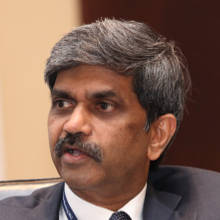Seeing Around Corners
How to Spot Inflection Points in Business Before They Happen
By Rita McGrath
Insights from Columbia Business School professor Rita McGrath’s book ‘Seeing Around Corners: How to Spot Inflection Points in Business Before They Happen’
D ShivakumarBy Rita McGrath

“A strategic inflection point is a time in the life of a business when its fundamentals are about to change” - Andy Grove
2 of 56
Some common triggers for an inflection point
3 of 56
Inflection points can take a lot of time to unfold. Then build gradually and change suddenly. Inflection points change the very assumptions on which the organization was founded.
4 of 56
The progress of inflection points is not linear. They proceed in fits and starts, and while they are emerging, it is normal for reasonable people to disagree about their importance.
5 of 56
There are four stages in the development of inflection points: hype, dismissive, emergent, and maturity.
6 of 56
While logging on to a website, most of us think we are just logging on to that site. We don’t realize that third parties with whom we have no relationship at all are watching us.
7 of 56
Most of us know that the internet is a bit of the Wild West when it comes to our privacy.
8 of 56
According to The New York Times, no fewer than 50 governments have put measures in place to claw back access.
9 of 56
My argument is that the basic inflection point has arrived for Facebook and other advertising-fueled data-gathering organizations.
10 of 56
Giants have fallen before. The failure to see the storms coming led to the demise of Nokia. In 2007, Forbes ran a cover article which said “can anyone catch Nokia?”
11 of 56
If snow melts at the edges, it behooves you to have mechanisms in place to see what’s going on there.
12 of 56
There are 8 practices
13 of 56
The main point is that the future doesn’t happen at once. It begins to unfold evenly. If you can interview it when it is starting, you will be better placed.
14 of 56
Fast broadband as we know it started around 2000 and took off around 2007. That’s when half the US population had access to laptops and broadband connections.
15 of 56
It is easy to speculate what inflection points could become. However, in the early stages they are incomplete in many ways.
16 of 56
In the Steve Ballmer era, Microsoft failed to see five things
17 of 56
If you can see the object far down the road, you need only a small turn to avoid it. However, if you don’t, you will crash headlong into it.
18 of 56
There are three types of indicators: lagging, current, and leading.
19 of 56
Most businesses are run on lagging indicators—profits, revenues, ROI, EPS
20 of 56
Current indicators give you information about the current state of things. Entire systems like ERP have been built to answer the question, ‘what’s going on now?’
21 of 56
Leading indicators represent things that are not facts in your business. They have potential to lead to facts later on.
22 of 56
| Lagging | Current | Leading |
| Customer churn | Customer satisfaction | Employee engagement |
| Employee turnover | Employee engagement | Management effectiveness |
| Revenue from new products | Customer usage | Customer love |
Today 63% of food from US restaurants is taken out, i.e. not consumed inside the restaurant. So, it’s a packaged business.
24 of 56
One way to think about this is to ask, what if everything remained the same, but only one variable changed in my business?
25 of 56
The university degree may well be the last barrier standing between traditional education models and a major disruption.
26 of 56
60% of those surveyed on LinkedIn believe that employees will be hired on skills in future, rather than degree or pedigree. It is already happening in coding.
27 of 56
Purdue University is trying a new disruption—the income sharing agreement (ISA) wherein the education is free and students pay a part of their salary as and when they start earning.
28 of 56
Clayton Christensen said, in future, brands of colleges will give way to brands of college professors, i.e. who taught you.
29 of 56
The growing mismatch between what made a company successful and the environment it finds itself in now eventually leads to underperformance.
30 of 56
Apparel is going through product fatigue.
31 of 56
Zara has made the creation and distribution of brands a non-stop cycle, giving rise to fast fashion.
Customers cannot be hostages, i.e. hostages to some rule or method—like DVD rental firm Blockbuster had late fees.
33 of 56
Netflix wasn't the first to enter into original content production. However, unlike others, it had 15 years of data of what consumers were watching and liked.
34 of 56
If you sliced out only healthcare spending in America, that sum would be the fifth largest GDP in the world.
35 of 56
The techniques described in the book are not about making predictions and being right. They are about generating possibilities and opening your mind to what might happen.
36 of 56
Intel has employed science fiction writers, futurists and students to produce a narrative of the future. This helps them to open their minds to emerging possibilities.
37 of 56
Having seen an inflection point coming, the real dilemma for a decision maker is still the uncertainty that prevails.
38 of 56
The key is being discovery-driven and not think that you have all the answers.
39 of 56
Digitization simply means replacing analog activity with connected activity with a technology layer.
40 of 56
Digital is at its most disruptive when it changes the fundamentals of the business model. In insurance, digital models have the ability to alter distribution, pricing, and claims.
41 of 56
The BBC saw the advent of digital media and appointed Siemens to study this. This was delegated to junior levels and flopped.
42 of 56
Fall in love with the problem, not the solution.
43 of 56
Habitual entrepreneurs have their own methods to see around corners. They have a good network for advice, resources and insights.
44 of 56
Galvanizing the organization is important. Satya Nadella spoke of empathy in Microsoft which was used to turf wars and everyone shooting the other person.
45 of 56
A classic tension in any organization is the tension between exploiting a repeatable business model and identifying a new one.
46 of 56
Culture, strategy and incentives matter. In Microsoft, now incentives are not about selling software as much as how much of it is used by the enterprise.
47 of 56
Inflection points challenge the assumptions of how you run your business and allocate resources.
48 of 56
Leadership is about relentless alignment and collaboration.
49 of 56
The key role of a CEO is to keep the team on the same page and keep working together.
50 of 56
CEOs need to move from command-and-control to leading by seeking feedback.
51 of 56
Build aligned and trusted teams that can move quickly.
52 of 56
Alan Mullaly’s Ford ‘working together’ document
53 of 56
Turnaround CEOs need to follow SPARK:
54 of 56
Negative or unexpected feedback can be a gift when you need to see around corners for your own career.
55 of 56
According to a LinkedIn survey, those who reach the top have an ability to accumulate diverse skills and show an ability to learn about things they are initially uncomfortable about.
56 of 56
By Rita McGrath
Was this article useful? Sign up for our daily newsletter below
About the author

Shivakumar is Operating Partner at Advent International. Before this, he was President (Corporate Strategy and Business Development) at Aditya Birla Group. Earlier assignments include: Chairman & CEO at Pepsico India and prior to that, Managing Director at Nokia India. Before joining Nokia, he worked with consumer electronics maker Philips and top consumer goods firm Hindustan Unilever. He is an engineer from IIT Chennai and an MBA from IIM Calcutta.
Shivakumar has written three books: Reflections - a collection of Shivs articles; The Right Choice - Resolving Ten Career Dilemmas; and The Art of Management. The latter two are business bestsellers.
Also by me
Trending